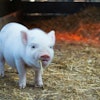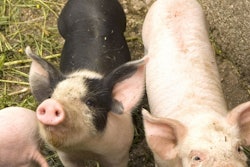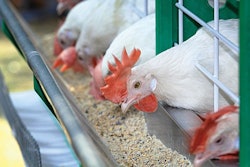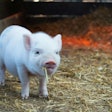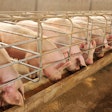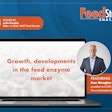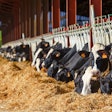
Extruded full-fat linseed is more expensive than similar soybean products, but offers a rich source of omega-3 fatty acids
One of the major issues facing the broiler industry in the next decade is chick quality. It remains hard to define this term accurately, but it all comes down to an early and efficient start that translates to a profitable finish. Here, we need to consider two aspects of modern broiler production:
First, the commercial life of a broiler chick is roughly 42 days, but its life begins 21 days sooner, at the time the egg is placed in the incubator. In fact, if we allow for the egg yolk formation period of roughly another week, we have a total of 10 weeks, during which we can influence broiler performance.
Of these 10 weeks, 50% includes the period of what concerns early nutrition. That is from the time egg yolk starts to form in the liver of the hen until the chick is one-week old. Historically, research has focused on the second half of this period, but researchers now realize the emphasis must be on the first half, as well. To this end, breeder nutrition (egg-yolk formation), in-ovo treatments (during incubation), and early broiler super pre-starter feeds are all part of modern poultry research efforts.
The second aspect, recently argued by researchers from the Wageningen University in the Netherlands and the Roslin Institute in the U.K. (Poultry Science, 2020, 99(4):2162), is that residual egg yolk sac diminishes in quantity with each passing generation of stock breeding. As we all know, residual egg yolk is what provides newly hatched chicks the most nutrients during the first 24 to 48 hours. This observation is likely the result of genetic improvement that has increased metabolic rate during incubation, thus leaving less nutrients available to the newly hatched chick. The efficiency of utilization of nutrients from the egg yolk sac has not changed, which means larger eggs should continue to support better chick quality.
Lipids in egg yolk
In terms of nutrients, fat remains the most important one in egg yolk because it is the primary energy for the hatching and newly hatched chick. Hens, like any monogastric animal, deposit the fats they consume through their feed without modifying them. So, if feed contains mostly unsaturated lipids, then the egg yolk will include the very same form, and likewise with saturated. Although we can hardly increase the amount of lipids/energy in an egg (unless we modify its size), we have great flexibility in modifying its lipid profile. And this is where we can use this metabolic idiosyncrasy of the hen to improve chick quality.
It is equally important to realize that, apart from energy, certain fatty acids possess functional properties, the most widely known being omega-3 fatty acids. Briefly, omega-3 fatty acids boost the immune system of the animal, improving its resistance to disease. This becomes of primary importance today as we are removing antimicrobial compounds from broiler feeds with alarming speed — even for therapeutic purposes. And, the immediate post-hatch period is when the chick is the most vulnerable in terms of health challenges.
Because feed intake during the first few days post-hatch is minimal — averaging 20 grams per day during the first week — getting an early boost of omega-3 fatty acids from the resorbed egg yolk, in addition to those found in the early pre-starter feed, appears like a sound practice to improve overall chick quality and lifetime performance.
Sources of omega-3 fatty acids
It can be argued then that feeding breeder hens with a stable source of omega-3 fatty acids will increase concentration in egg yolk, resulting in improved chick quality. It is most likely it will benefit hen health and productivity, and perhaps egg hatchability, but these are parts of another discussion. That feeding hens omega-3 fatty acids results in such enriched eggs being laid is beyond the phase of proof as omega-3 eggs are already a growing niche market for human consumption. What remains to determine is what sources of omega-3 fatty acids are available for commercial farming. Here are our current choices:
- Fish meal
Depending on fish species (the fattier, the better), fish meal contains up to 10% fish oil, which is very rich in omega-3 fatty acids, especially DHA (docosahexaenoic acid) and EPA (eicosapentaenoic acid). Fish meal and oil are highly sought after from the aquafeed industry and, thus, marine products have become an expensive specialty for farm animal feeding. The focus, hence, must be placed on plant sources.
- Linseed
The oil of linseed (flaxseed) remains the primary source of plant omega-3 fatty acids as it contains up to 50% ALA (alpha-linolenic acid). This is a precursor to DHA and EPA in animals. Usage of refined linseed oil is one method used to produce omega-3 enriched eggs, but it has its limitations, as it can be a somewhat bitter substance and is prone to rapid oxidation. Extruded full-fat linseed is a practical alternative to linseed oil for animal feeds.
- Canola and soybean oils
Surprisingly, canola and soybean oil contain up to 10% and 7% ALA, respectively, which are figures not as impressive as that of linseed oil, requiring relatively impractical levels of addition. Even when full-fat extruded canola or soybeans are used, the needed inclusion levels remain relatively high, promoting protein wastage.
- Micro-algae
This is the newest addition to the range of omega-3 fatty acid sources. The oil is high in DHA (more than 60%) but low in EPA (0.6%). Nevertheless, this is a new technology that requires still much refinement, whereas micro-algae oil remains relatively expensive and not readily available worldwide as it is used in human nutrition supplements.
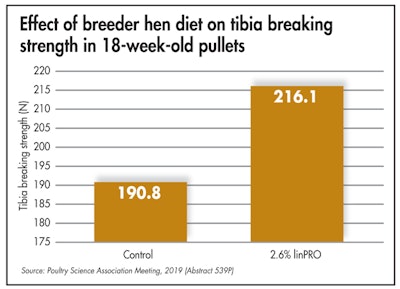 Pullets fed 0.5% linseed oil from a 2.5% extruded full-fat linseed product had stronger skeletons when they entered the laying phase. (Poultry Science, 2020 (99(4):2087))
Pullets fed 0.5% linseed oil from a 2.5% extruded full-fat linseed product had stronger skeletons when they entered the laying phase. (Poultry Science, 2020 (99(4):2087))Research evidence
A published study from the University of Guelph in Canada indicated that feeding growing breeder layers with just 0.5% oil (from 2.5% of an extruded full-fat linseed product) resulted in pullets entering the laying phase with a robust skeleton (Poultry Science, 2020, 99(4):2087). Such an outcome implies stronger eggshells, larger laying clusters and less culling due to skeletal issues.
A spinoff from the above study, soon to be published (2019 Poultry Science Association Meeting, abstract 539P), indicated that broiler breeders receiving a similar diet (0.5% linseed oil from 2.5% extruded full-fat linseed product) transferred the omega-3 beneficial lipids to their eggs resulting in better quality chicks. At harvest, such broilers had an average 10% higher breast meat yield compared with control.
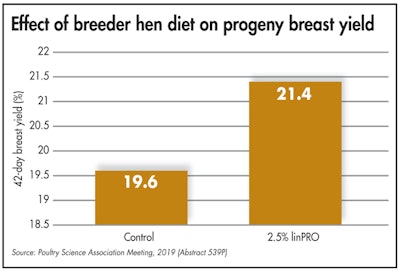 Broiler breeders receiving diets including 0.5% linseed oil from 2.5% extruded full-fat linseed product transferred omega-3 lipids to their eggs and produced higher quality chicks. (2019 Poultry Science Association Meeting, Abstract 539P)
Broiler breeders receiving diets including 0.5% linseed oil from 2.5% extruded full-fat linseed product transferred omega-3 lipids to their eggs and produced higher quality chicks. (2019 Poultry Science Association Meeting, Abstract 539P)In brief
Commercial evidence suggests a higher health status in breeders, better chick quality in their offspring, and overall improved performance with extruded full-fat linseed. But, it must be noted that extruded full-fat linseed is not as inexpensive as soybean meal plus soy oil. Thus, any benefits should be weighed against the extra expenditure. In my opinion, complaints regarding poor chick quality should be addressed starting at the breeder stage and continue until the chick is one week old.
